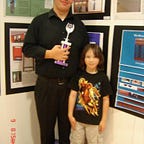Maker Project
In order to create something for the maker project, I decided to follow the steps from https://digital-photography-school.com/make-abstract-glitch-art-photographs/ in order to create something that I have found interesting for a while now, glitch art. Although the instructions are written fairly well and are easy to follow, it immediately assumes that you have some experience with, and own, both computers as well as Photoshop and audacity. These I did happen to both have readily due to my graphic design background, but for many average people, this may already be a hard step in continuing to create the final product that they were hoping for. It seems as though the audience that was intended for these instructions, were people who already had some experience with digital photography or graphic design, even adding in a fun little bit as a foreword to the instructions as a sort of fun engagement to the process. Admittedly though, after the first couple steps, the instructions pick up with a more tutorial like depth to the steps rather than larger assumptions. They seem to be written in a way that when utilized by the correct audience, are an easy to understand, quick paced way of creating a more recently popular style of art. The images accompanying the text also help out immensely, letting you know how each of the steps should look like as you are completing them and where you may have gone wrong, but at times, they are also substituted for text, where it may have been beneficial to include both in the instructions for better understanding. The instruction also deal with a fair bit of trial and error, resetting your image and trying different options with it, but the final productions are an interesting sight to look at, although I feel like a way to make the production better might be to figure out a way to be either more precise or targeted with whatever changes you might be trying to make. Also there may be a benefit from images from multiple different effects such as the concluding images from https://critiquecollective.com/2014/03/13/tutorial-on-databending-and-glitch-art/ , allowing for examples of which of the effects might either work better than others, or just work at all. While I was working through the steps, I found that the past experience that I had made it fairly easy to complete, and after I completed it once or twice, I could more or less repeat the process easily without any assistance. I did feel like, as stated before, that the repeated trial and error of the process is needed to really grasp both the concepts of the digital design and the changes that you create to your original product.
